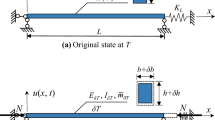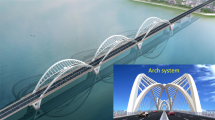Abstract
Temperature load is one of the most common and vital environmental loads for bridge in-service. However, the significant variability of temperature and the time-lag effect severely affects the damage identification and structure evaluation based on temperature response. The time-lag effect refers to the phenomenon that the temperature-induced response lags behind the temperature itself. Through a large amount of measured data mining, this paper summarizes the typical characteristics and general laws of the time-lag effect. Besides, the numerical simulation of the time-lag effect is realized via the finite element method. Furthermore, the spatial and temporal mechanism of the time-lag effect is explored. The extensive numerical simulation results and measured data verification revealed that the temperature change rate is the root cause of the time-lag effect. And the time delay of temperature-induced strain is just the appearance. Finally, based on the mechanism of the time-lag effect, an elimination method is proposed, which adopts the temperature change rate and temperature amplitude as key indexes. With this method, the stable slope of temperature-induced strain can be gained. This provides a solid basis for further structural evaluation based on the temperature effect. The exploration of the time-lag effect mechanism deepens the understanding of the temperature response and provides a new perspective for the structural early warning and assessment based on temperature load.



















Similar content being viewed by others
Data availability
Some or all data, models, or code generated or used during the study are proprietary or confidential in nature and may only be provided with restrictions (e.g. anonymized data) (List items and restrictions).
References
Xu YL, Chen B, Ng CL, Wong KY, Chan WY (2010) Monitoring temperature effect on a long suspension bridge. Struct Control Heal Monit 17(6):632–653. https://doi.org/10.1002/stc.340
Brownjohn JM, Kripakaran P, Harvey B, Kromanis R, Jones P, Huseynov F (2016) Structural health monitoring of short to medium span bridges in the United Kingdom. Struct Monit Maint; 3(3): 259–276. https://doi.org/10.12989/smm.2016.3.3.259
Westgate R, Koo KY, Brownjohn J (2015) Effect of solar radiation on suspension bridge performance. J Bridge Eng 20(5):04014077. https://doi.org/10.1061/(ASCE)BE.1943-5592.0000668
Zhou C, Chase JG, Rodgers GW (2019) Degradation evaluation of lateral story stiffness using HLA-based deep learning networks. Adv Eng Inform 39:259–268. https://doi.org/10.1016/j.aei.2019.01.007
Huang JZ, Li DS, Li HN, Song GB, Liang Y (2018) Damage identification of a large cable-stayed bridge with novel cointegrated Kalman filter method under changing environments. Struct Control Heal Monit 25(5):e2152. https://doi.org/10.1002/stc.2152
Kromanis R, Kripakaran P (2014) Predicting thermal response of bridges using regression models derived from measurement histories. Comput Struct 136:64–77. https://doi.org/10.1016/j.compstruc.2014.01.026
Xia Q, Cheng Y, Zhang J, Zhu F (2017) In-service condition assessment of a long-span suspension bridge using temperature-induced strain data. J Bridge Eng; 22(3): 04016124. https://doi.org/10.1061/(ASCE)BE.1943-5592.0001003
Hedegaard BD, French CE, Shield CK (2017) Time-dependent monitoring and modeling of I-35W St. Anthony Falls Bridge. II: Finite-element modeling. J Bridge Eng; 22(7): 04017026. https://doi.org/10.1061/(ASCE)BE.1943-5592.0001053
Tayşi N, Abid S (2015) Temperature distributions and variations in concrete box-girder bridges: experimental and finite element parametric studies. Adv Civ Eng 18(4):469–486. https://doi.org/10.1260/1369-4332.18.4.469
Xia Q, Zhang J, Tian Y, Zhang Y (2017) Experimental study of thermal effects on a long-span suspension bridge. J Bridge Eng 22(7):04017034. https://doi.org/10.1061/(ASCE)BE.1943-5592.0001083
Liang Y, Li D, Song G, Feng Q (2018) Frequency Co-integration-based damage detection for bridges under the influence of environmental temperature variation. Measurement 125:163–175. https://doi.org/10.1016/j.measurement.2018.04.034
Sun LM, Zhang W, Nagarajaiah S (2019) Bridge real-time damage identification method using inclination and strain measurements in the presence of temperature variation. J Bridge Eng 24(2):04018111. https://doi.org/10.1061/(ASCE)BE.1943-5592.0001325
Zhu Y, Ni YQ, Jin H, Inaudi D, Laory I (2019) A temperature-driven MPCA method for structural anomaly detection. Eng Struct 190:447–458. https://doi.org/10.1016/j.engstruct.2019.04.004
Liu, H., Wang, X., & Jiao, Y. (2016) Effect of temperature variation on modal frequency of reinforced concrete slab and beam in cold regions. Shock Vib; https://www.hindawi.com/journals/sv/2016/4792786/
Khandel O, Soliman M, Floyd RW, Murray CD (2020) Performance assessment of prestressed concrete bridge girders using fiber optic sensors and artificial neural networks. Struct Infra struct Eng, 1–15. https://doi.org/10.1080/15732479.2020.1759658
Kromanis R, Kripakaran P (2021) Performance of signal processing techniques for anomaly detection using a temperature-based measurement interpretation approach. J Civ Struct Health Monit 11(1):15–34. https://doi.org/10.1007/s13349-020-00435-y
Zhou P, Zhang W, Wang J, Liu J, Su R, Xuemin W (2016) Multimode optical fiber surface plasmon resonance signal processing based on the Fourier series fitting. Plasmonics 2016; 11(3), 721–727. https://doi.org/10.1007/s11468-015-0100-6
Zhao HW, Ding YL, Nagarajaiah S, Li AQ (2019) Behavior analysis and early warning of girder deflections of a steel-truss arch railway bridge under the effects of temperature and trains: case study. J Bridge Eng 24(1):05018013. https://doi.org/10.1061/(ASCE)BE.1943-5592.0001327
Ding YL, Zhao HW, Li AQ (2017) Temperature effects on strain influence lines and dynamic load factors in a steel-truss arch railway bridge using adaptive FIR filtering. J Perform Constr Facil 31(4):04017024. https://doi.org/10.1061/(ASCE)CF.1943-5509.0001026
Chen C, Wang Z, Wang Y, Wang T, Luo Z (2017) Reliability assessment for PSC box-girder bridges based on SHM strain measurements. J Sens; https://doi.org/10.1155/2017/8613659.
Zhou L, Xia Y, Brownjohn JM, Koo KY (2016) Temperature analysis of a long-span suspension bridge based on field monitoring and numerical simulation. J Bridge Eng 21(1):04015027. https://doi.org/10.1061/(ASCE)BE.1943-5592.0000786
Obrien EJ, Heitner B, Žnidarič A, Schoefs F, Causse G, Yalamas T (2020) Validation of bridge health monitoring system using temperature as a proxy for damage. Struct Control Heal Monit; 27(9), e2588. https://doi.org/10.1002/stc.2588
Kuryłowicz-Cudowska A (2019) Determination of thermophysical parameters involved in the numerical model to predict the temperature field of cast-in-place concrete bridge deck. Materials 12(19):3089. https://doi.org/10.3390/ma12193089
Li K, Hong N (2018) Dynamic heat load calculation of a bridge anti-icing system. Appl Therm Eng 128:198–203. https://doi.org/10.1016/j.applthermaleng.2017.09.024
Yang K, Ding Y, Sun P, Zhao H, Geng F (2019) Modeling of temperature time-lag effect for concrete box-girder bridges. Appl Sci-Basel 9:1–15. https://doi.org/10.3390/app9163255
Yang DH, Yi TH, Li HN et al (2018) Correlation-based estimation method for cable-stayed bridge girder deflection variability under thermal action. J Perform Constr Facil 32(5):04018070. https://doi.org/10.1061/(ASCE)CF.1943-5509.0001212
Jiang H, Wan C, Yang K, Ding Y, Xue S (2021) Modeling relationships for field strain data under thermal effects using functional data analysis. Measurement; 109279. https://doi.org/10.1016/j.measurement.2021.109279
Guo T, Liu J, Zhang Y, Pan S (2015) Displacement monitoring and analysis of expansion joints of long-span steel bridges with viscous dampers. J Bridge Eng 20(9):04014099. https://doi.org/10.1061/(ASCE)BE.1943-5592.0000701
Bai X, Yang N, Yang Q (2018) Temperature effect on the structural strains of an ancient Tibetan building based on long-term monitoring data. Earthq Eng Eng Vib 17(3):641–657. https://doi.org/10.1007/s11803-018-0437-x
Acknowledgements
The authors sincerely acknowledge financial support from the National Natural Science Foundation of China (Grants. 52378288, 51978154, 51608258, and 52008099), the Fund for Distinguished Young Scientists of Jiangsu Province (Grant. BK20190013), the Natural Science Foundation of Jiangsu Province (Grant BK20200369), and Key Research and Development Program of Nanjing Jiangbei New Area (Grant. ZDYF20200118).
Author information
Authors and Affiliations
Corresponding author
Ethics declarations
Conflict of interest
The authors declare that they have no known competing financial interests or personal relationships that could have appeared to influence the work reported in this paper.
Additional information
Publisher's Note
Springer Nature remains neutral with regard to jurisdictional claims in published maps and institutional affiliations.
Rights and permissions
Springer Nature or its licensor (e.g. a society or other partner) holds exclusive rights to this article under a publishing agreement with the author(s) or other rightsholder(s); author self-archiving of the accepted manuscript version of this article is solely governed by the terms of such publishing agreement and applicable law.
About this article
Cite this article
Yang, K., Ding, Y., Jiang, H. et al. Time-lag effect of temperature-induced strain for concrete box girder bridges. J Civil Struct Health Monit 14, 303–320 (2024). https://doi.org/10.1007/s13349-023-00725-1
Received:
Accepted:
Published:
Issue Date:
DOI: https://doi.org/10.1007/s13349-023-00725-1




